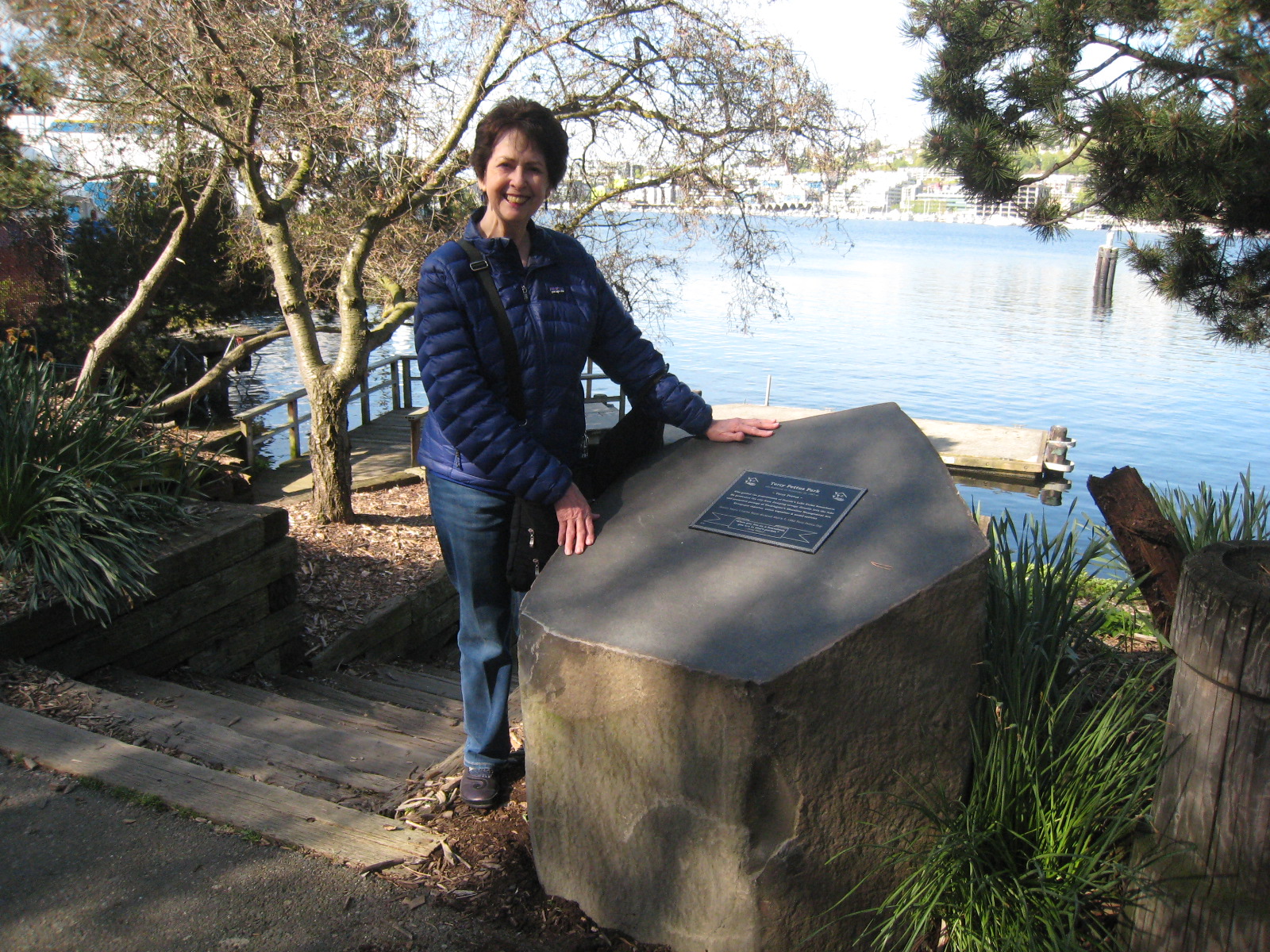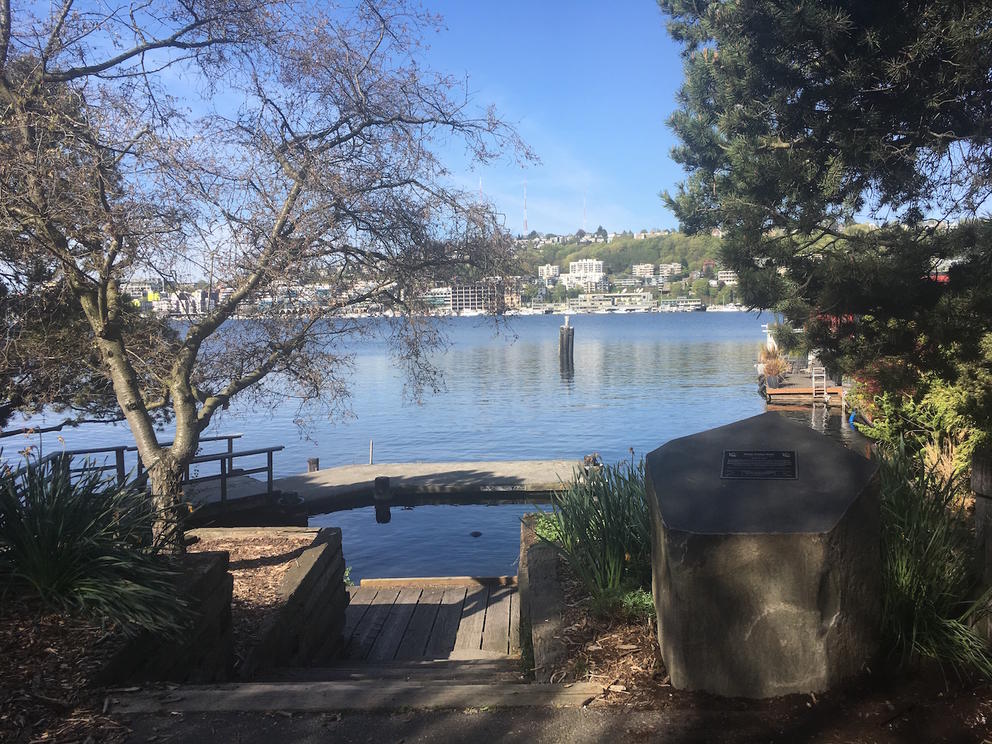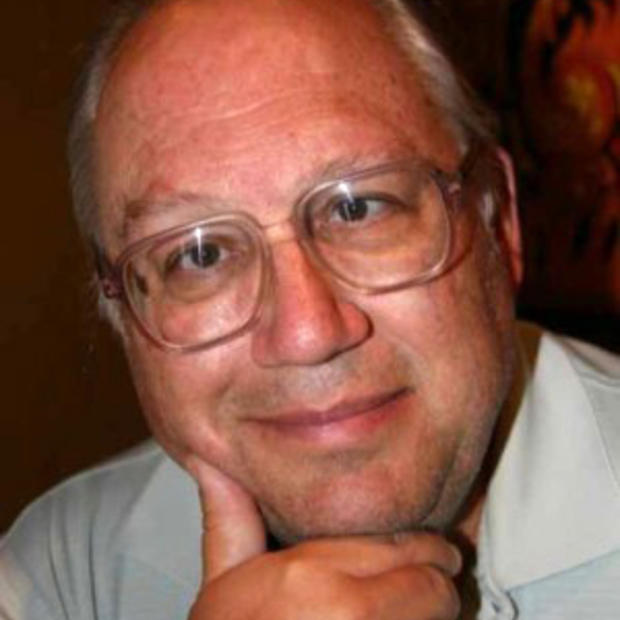Dixie Pintler had told her nephew all about Lake Union’s venerable houseboats and the historic fight that saved not only them, but the lake as well. Then last fall, she took him to see a park dedicated in honor of the man who had led that houseboat fight. The park is pocket-sized, just south of the houseboats lining the lake’s eastern shore.
At first, it was hard to find, hidden by rows of parked cars. The sign reading “Terry Pettus Park” was faded, torn, and not easily visible from the road.
But that’s not what bothered Pintler, a youthful 84-year old who’d been a close friend of Pettus, an all-but-forgotten Seattle legend.
“When we arrived at the park, I was stunned at the condition it was in,” Pintler says. She took photos of the empty, overgrown, and forlorn site and its neglected dock, and sent them to the Seattle Parks Department. “The upshot of that was that the parks department was extremely surprised at how badly deteriorated it had become — it had fallen through the cracks.”
For Pintler, a onetime houseboater who now lives in Edmonds, that response was an opportunity. She still possesses the personality and energy that made her the first car saleswoman in the Pacific Northwest (and third in the United States), back in 1972 in Port Angeles.
Other than his name on the entrance sign there was no information about Pettus at the park at all. Pintler spent months with various officials discussing options for honoring Pettus. They agreed on the idea of a plaque on a boulder. Designed by Dixie’s son Bill Johnson, the plaque was installed in April and provides a short history of the man who inspired her.
She has her own story about Pettus. “After I moved to Seattle in 1975 and ended up living on a houseboat, Terry Pettus was one of the first people I met,” Pintler remembers. “I loved just stopping by his boat and listening to his stories. No one in my life ever influenced me like he did.”
He was was 71 years old when they first met — Pettus was in the thick of a campaign to prevent Lake Union’s houseboats from being expelled from their moorages. The city complained about their untreated sewage, even though the lake had been polluted for decades by industrial debris and toxins.
Pettus, who had moved into a Lake Union houseboat years earlier, was not one to shy away from a challenge. He organized what is today the Floating Homes Association and encouraged houseboat owners to tax themselves to pay for cleaning up the lake, even though other waterfront homes and businesses had contributed to its contamination. He went on to help craft Washington’s Shoreline Management Act.
Born the son of a minister in Terre Haute, Indiana, Pettus came west to Puget Sound in 1927 and began working as a newspaper journalist. He helped start the Pacific Northwest Newspaper Guild and in 1936 was a leader of the first successful strike against publisher William Randolph Hearst’s nationwide media empire, forcing the Seattle Post-Intelligencer to recognize the union as a bargaining agent.
The suffering of the Great Depression made a radical out of Pettus. He joined the Communist Party USA in 1938 and became active in the Washington Commonwealth Federation (WCF), a left-wing coalition in the state Democratic Party, editing the WCF’s newspaper, The New Dealer. The WCF elected many local and state officeholders during World War II as well as a Congressman, Seattle’s Hugh De Lacy. Though communists were only a part of the Federation, their role led to its demise in 1948 at the hands of the Canwell Committee, a Washington State precursor to the infamous McCarthy-era witch hunts in the 1950s
Pettus was open about being a Communist. After the WCF dissolved, he became editor of the Party’s newspaper, The People’s World. He spent time in jail for his party activism, then left the Party in 1958, objecting to its increasingly authoritarian structure. Blacklisted, he was unable to find employment, and for a time wrote pulp fiction under pseudonyms to survive.
He never apologized for his Communist affiliation. “I have nothing to apologize for,” Pintler recalls him saying. “I fought for old-age pensions, the right to organize, and a minimum wage, and against racism and discrimination. Apologize for that?”
Eventually, the battle to save Lake Union and its houseboats restored his reputation. When Pettus died in 1984, he was celebrated as a hero who represented both Seattle’s rough-and-tumble labor history and its emerging environmental awareness. Mayor Charles Royer declared March 7, 1982, as “Terry Pettus Day” in Seattle, and many of the city’s elite turned out to applaud his activism.

The city is planning to remodel Terry Pettus Park. “The long-term plans are going to be fantastic,” Pintler says. Cement steps will replace the rotting wooden stairs that lead to the lake. New shrubbery will also be planted.
In time, Pintler hopes the park can be fully rehabilitated, with photographs and interpretive signs informing visitors about Pettus. “It pleases me to no end to be able to do something for Terry,” she says. “I loved him dearly and I miss the hell out of him!”
In an era when massive new construction is erasing much of Seattle’s history, and tent encampments of the homeless begin to resemble the “Hoovervilles” of the Great Depression, it’s worth paying respect to a Seattle crusader for justice— and to a city that once took great pride in its vibrant working class.
On June 2, beginning at 1 p.m., Dixie Pintler will lead a ribbon-cutting ceremony for the new plaque at the park (on Fairview Avenue East at East Newton Street). The public is welcome.



